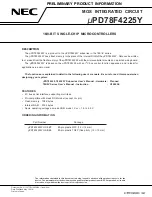
10.11.4 Address Field
The address field of a message frame contains 8 bits. Valid follower device addresses are in the range of 0–247 decimal. The
individual follower devices are assigned addresses in the range of 1–247. (0 is reserved for broadcast mode, which all
followers recognize.) A master addresses a follower by placing the follower address in the address field of the message.
When the follower sends its response, it places its own address in this address field to let the master know which follower is
responding.
10.11.5 Function Field
The function field of a message frame contains 8 bits. Valid codes are in the range of 1-FF. Function fields are used to send
messages between master and follower. When a message is sent from a master to a follower device, the function code field
tells the follower what action to perform. When the follower responds to the master, it uses the function code field to
indicate either a normal (error-free) response, or that an error has occurred (called an exception response). For a normal
response, the follower simply echoes the original function code. For an exception response, the follower returns a code that
is equivalent to the original function code with its most significant bit set to logic 1. In addition, the follower places a
unique code into the data field of the response message. This code tells the master what error occurred, or the reason for
the exception. See
chapter 10.11.10 Function Codes Supported by Modbus RTU
.
10.11.6 Data Field
The data field is constructed using sets of two hexadecimal digits, in the range of 00 to FF hexadecimal. These sequences
are made up of one RTU character. The data field of messages sent from a master to follower device contains more
information, which the follower must use to do what is defined by the function code. This information can include items
such as coil or register addresses, the quantity of items, and the count of actual data bytes in the field.
10.11.7 CRC Check Field
Messages include an error-checking field, operating based on a Cyclical Redundancy Check (CRC) method. The CRC field
checks the contents of the entire message. It is applied regardless of any parity check method used for the individual
characters of the message. The transmitting device calculates the CRC value then appends the CRC as the last field in the
message. The receiving device recalculates a CRC during receipt of the message and compares the calculated value to the
actual value received in the CRC field. If the two values are unequal, a bus timeout results. The error-checking field contains
a 16-bit binary value implemented as two 8-bit bytes. After error-checking, the low-order byte of the field is appended first,
followed by the high-order byte. The CRC high-order byte is the last byte sent in the message.
RS-485 Installation and Set...
Design Guide
276
Danfoss A/S © Rev. 2014-02-10 All rights reserved.
MG34S222
10
10
Содержание VLT AutomationDrive FC 300
Страница 2: ......
















































